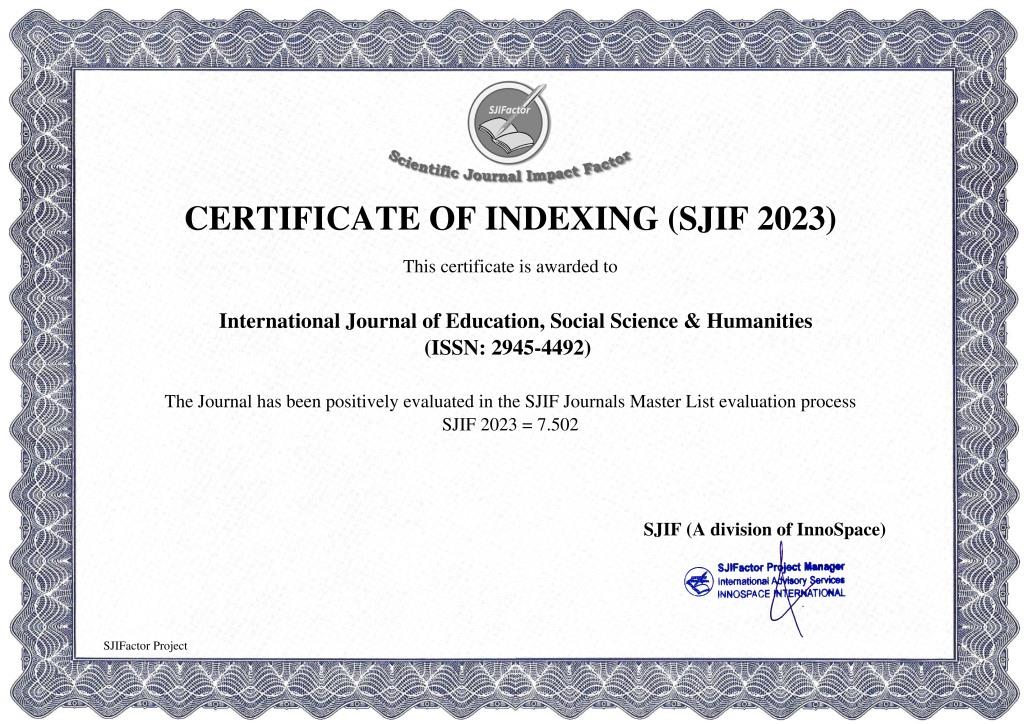СОСТОЯНИЕ ГИГИЕНЫ ПОЛОСТИ РТА У ЛИЦ С СЕРДЕЧНО-СОСУДИСТЫМИ ЗАБОЛЕВАНИЯМИ И СОПУТСТВУЮЩИМИ ФАКТОРАМИ РИСКА
Abstract
Скрининг у стоматолога и полости рта может стать новейшим оружием в выявлении лиц с риском сердечно-сосудистых заболеваний. Инфекции полости рта, в частности пародонтит, могут представлять независимый риск различных системных состояний. Факторы риска, связанные с сердечно-сосудистыми заболеваниями, также предполагают, что взаимосвязь между заболеваниями пародонта и диабетом работает в обоих направлениях. Цель этого исследования состояла в том, чтобы поддержать и укрепить связь и взаимосвязь между состоянием гигиены полости рта у людей с сердечно-сосудистыми заболеваниями и связанными с ним факторами риска. 200 жителей были вибраны случайным образом из Ферганской области Республики Узбекистан. Посещение полости рта и осмотр проводились у равного количества мужчин и женщин разных возрастных групп с сердечно-сосудистыми заболеваниями. Оценка состояния полости рта проводилась с помощью индекса гигиены полости рта, общего пародонтального индекса потребности в лечении и потери привязанности. Оценка состояния полости рта у больных с сердечно-сосудистыми заболеваниями и в контрольной группе показала статистически значимо низкий уровень состояния полости рта у больных с сердечно-сосудистыми заболеваниями по сравнению с контролем. Распространенность системных заболеваний в разных возрастных группах достоверно коррелировала с распространенностью тяжелых заболеваний пародонта. Лечение заболеваний десен может снизить риск сердечных заболеваний и улучшить состояние здоровья пациентов с заболеваниями пародонта и сосудистыми заболеваниями сердца.
References
Rose LF, Mealey B, Minsk L, Cohen W. Oral care for patients with cardiovascular disease and stroke. J Am Dent Assoc 2002: 133:37S-47.
Socransky SS, Smith C, Haffajee AD. Subgingival microbial profiles in refractory periodontal disease. J Clin Periodontol 2002;29:260-8.
Meurman JH, Pyrhönen S, Lindqvist C. Oral sources of septicaemia in patients with malignancies. Oral Oncol Eur J Cancer 1997;33:389-97.
Beck J, Garcia J, Heiss G. Periodontal disease and cardiovascular disease. J Periodontol 1996;67:1123-37.
de Stefano F, Anda RF, Kahn HS. Dentaldisease and risk factor coronary heart disease. BMJ 1993;306:688-91.
Mattila KJ, Valtonen VV, Nieminen M, Huttunen JK. Dental infection and the risk of new coronary events: prospective study of patients with documented coronary artery disease. J Clin Infect Dis 1995;20: 588-92.
Renvert S. Destructive periodontal disease in relation to diabetes mellitus, cardiovascular disease, osteoporosis and respiratory disease. Oral Health Prev Dent 2003;1 Suppl 1:341-57.
Slavkin HC, Baum BJ. Relationship of dental and oral pathology to systemic illness. J Am Med Assoc 2000;284:1215-7.
Jukka H, Mariano Sanz MM, Sok-Ja Janket. Oral health, atherosclerosis, and cardiovascular disease. Crit Rev Oral Biol Med 2004;15:6:403-13.
Mager B. Presence of gum disease may help dentists and physicians identify those at increased risk for cardiovascular disease. New York-Presbyterian, November
, 2008. Available from: http://nyp. org/news/hospital/gum-disease-cardiovascular.html
Glavind L, Loe H. Errors in the clinical assessment of periodontal destruction. J Period Res 1967;2:180-4.
Halter JB. Diabetes mellitus. In: Hazzard WR, ed. Principles of geriatric medicine and gerontology. 4th ed. New York: McGraw-Hill; 1999. pp 991-1011.
Ship J. Diabetes and oral health. An overview. J Am Dent Assoc 2003;134:4S10S.
Taylor GW, Burt BA, Becker MP, et al. Glycemic control and alveolar bone loss progression in type 2 diabetes. Ann Periodontol 1998;3:30-9.
Grossi S. Treatment of periodontal disease and control of diabetes: an assessment of the evidence and need for future research. Ann Periodontol 2001;6:138-45.
Grossi SG, Skrepcinski FB, de Caro T. Treatment of periodontal disease in diabetics reduces glycated hemoglobin. J Periodontol 1997;68:713-9.
Iacopino AM. Periodontitis and diabetes interrelationships: role of inflammation. Ann Periodontol 2001;6:125-37.
Joshipura KJ, Rimm EB, Douglass CW, et al. Poor oral health and coronary heart disease. J Dent Res 1996;75:1631-6.
Danesh J, Collins R, Appleby P, Peto R. Association of fibrinogen, C-reactive protein, albumin, or leukocyte count with coronary heart disease: meta-analyses of prospective studies. J Am Med Assoc 1998; 279:1477-82.
Genco R, Offenbacher S, Beck J. Periodontal disease and cardiovascular disease: epidemiology and possible mechanisms. JAm Dent Assoc 2002;133 Suppl 1:14s-22s.
Castell JV, Andus T, Kunz D, Heinrich P. Interleukin-6: the major regulator of acute phase protein synthesis in man and rat.Ann N Y Acad Sci 1989;557:87-99.
Yamauchi-Takihara K, Ihara Y, Ogata A, etal. Hypoxic stress induces cardiac myocyte-derived interleukin-6. Circulation1995;91:1520-4.
Wick G, Schett G, Amberger A, et al. Is atherosclerosis an immunologically mediated disease? Immunol Today 1995;16:27-33.
Sojar HT, Glurich I, Genco RJ. Heat shock protein 60-like molecule from bacteroides forsythus and porphyromonar gingivalis: molecular mimicry (abstract 275). J Dent Res 1998;77:666.
Mattila KJ, Valtonen VV, Nieminen M, Huttunen JK. Dental infection with the
risk of new coronary events: prospectivestudy of patients with documented coronary artery disease. Clin Infect Dis 1995;20:588-92.














